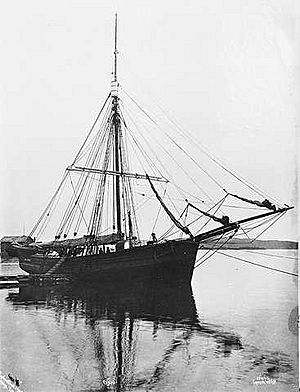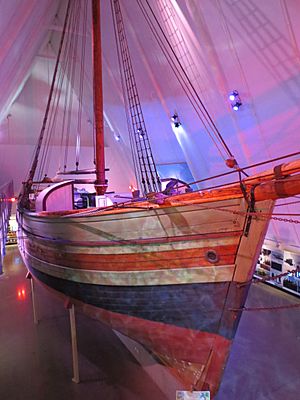Gjøa facts for kids
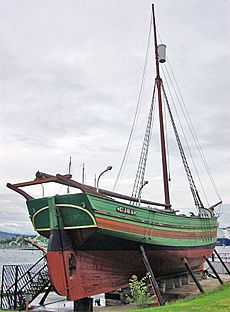
The Gjøa was a special ship. It was the first vessel to ever travel all the way through the Northwest Passage. This is a sea route that connects the Atlantic Ocean and the Pacific Ocean through the Arctic Ocean. With a crew of six, Roald Amundsen led this amazing journey. It took them three years to complete, finally finishing in 1906.
Contents
History
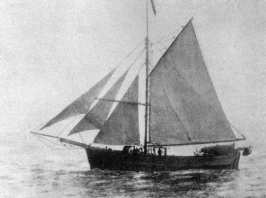
Building the Gjøa
The Gjøa was a type of boat called a sloop. It was about 70 feet long and 20 feet wide. It weighed 47 net register tonnage, which is a way to measure a ship's cargo space. Knut Johannesson Skaale built the ship in Rosendal, Norway, in 1872. This was the same year that Roald Amundsen was born! The ship was named Gjøa after the wife of its first owner. For the next 28 years, the Gjøa was used as a herring fishing boat.
Amundsen Buys the Ship
On March 28, 1901, Amundsen bought the Gjøa from Asbjørn Sexe. He wanted it for his big trip to the Arctic Ocean. The Gjøa was much smaller than other ships used for Arctic trips. But Amundsen planned to find food and supplies from the land and sea as they traveled. He knew that a small crew would need less food. This was important because a much larger expedition led by John Franklin had failed badly fifty years earlier.
The Gjøa also had a shallow bottom. This would help it sail through the shallow parts of the Arctic waterways. Most importantly, the Gjøa was an older ship, and it was all Amundsen could afford. He was paying for his expedition mostly with money he had inherited.
Amundsen didn't have much experience sailing in the Arctic. So, he decided to do a practice trip first. He hired Hans Christian Johannsen, the ship's previous owner, and a small crew. They sailed from Tromsø in April 1901. For five months, they hunted seals on the ice of the Barents Sea. When they returned in September, Amundsen fixed things on the Gjøa that the trip showed were needed. He added a small 13-horsepower engine. This engine helped the ship move in light winds and made it easier to handle. He also spent a lot of time making the ship stronger against ice. Amundsen knew the ship would be stuck in ice for several winters.
Journey Through the Northwest Passage
In the spring of 1902, the Gjøa was ready. Amundsen sailed it to Christiania (which is now Oslo), the capital of Norway. At that time, Norway was still part of Sweden. Amundsen hoped that the strong national pride in Norway would help him find people to pay for his trip. After a lot of effort, and a gift from King Oscar, he got the money he needed. By the time Amundsen returned from his journey, Norway had become an independent country. He and his crew were seen as heroes for their new nation.
Amundsen was the leader of the expedition and the captain of the Gjøa. His crew included:
- Godfred Hansen: A Danish naval officer and the Gjøa's first officer.
- Helmer Hanssen: Second officer and an expert ice pilot. He went on other trips with Amundsen later.
- Anton Lund: An experienced sealing captain.
- Peder Ristvedt: The chief engineer.
- Gustav Juel Wiik: Second engineer and a gunner from the Royal Norwegian Navy.
- Adolf Henrik Lindstrøm: The cook.
The Gjøa left the Oslofjord on June 16, 1903. It sailed towards the Labrador Sea near Greenland. From there, it crossed Baffin Bay and went through the narrow, icy passages of the Arctic Archipelago. By late September, the Gjøa was west of the Boothia Peninsula. The weather got worse, and there was more sea ice. Amundsen found a safe natural harbor on the south shore of King William Island. By October 3, the ship was completely stuck in the ice.
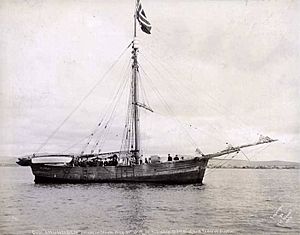
The ship stayed there for almost two years. During this time, the crew traveled by sled to measure the location of the North Magnetic Pole. They also learned a lot from the local Inuit people. The harbor where they stayed is called Uqsuqtuuq ("much fat") in the Inuktitut language. It has now become the only town on the island, called Gjoa Haven, Nunavut. Today, more than a thousand people live there.
The Gjøa left Gjoa Haven on August 13, 1905. It sailed through the tricky passages south of Victoria Island. From there, it went west into the Beaufort Sea. By October, the Gjøa was stuck in the ice again. This time, it was near Herschel Island in the Yukon. Amundsen left his men on the ship. He spent much of the winter skiing 500 miles south to Eagle, Alaska. He did this to send a telegram announcing that his expedition was a success. He returned in March, but the Gjøa stayed stuck in the ice until July 11.
The Gjøa finally reached Nome in Alaska on August 31, 1906. It then sailed on to San Francisco, California. The city had been badly damaged by an earthquake earlier that year. The expedition received a hero's welcome there on October 19.
In San Francisco
Instead of sailing the Gjøa all the way around Cape Horn and back to Norway, the Norwegian American community in San Francisco asked Amundsen to sell the ship to them. The ship was given to the city of San Francisco. It was pulled up onto the beach at the northwest corner of Golden Gate Park and put on display. Amundsen knew that because of his famous journey on the Gjøa, he would be able to use Nansen's ship Fram. The Fram was built especially for ice travel and was owned by the Norwegian government. So, Amundsen left the Gjøa in San Francisco. He and his crew traveled back to Norway on a regular ship. Sadly, only Gustav Juel Wiik did not return to Norway. He had died from an illness during the third Arctic winter.
Preservation
Over the years, the Gjøa slowly started to fall apart. By 1939, it was in bad condition. Repairs were delayed because of World War II. They were finally finished in 1949. But being outside for 66 years, facing strong winds, ocean salt, and sand, the ship got damaged again. In 1972, with help from Erik Krag, a Danish American shipping company owner from San Francisco, the Gjøa was returned to Norway. Erik Krag was even honored by the King of Norway for helping to bring the Gjøa home.
The Gjøa was first displayed at the Norwegian Maritime Museum in Bygdøy, Oslo. In May 2009, the Norwegian Maritime Museum and the Fram Museum agreed that the Fram Museum would take over showing the Gjøa. It is now displayed in its own building at the Fram Museum.
A special memorial pillar now stands near where the Gjøa used to be in San Francisco. The Gjøa was also used as a filming location in a 2005 documentary called The Search for the Northwest Passage. In that film, Kåre Conradi played Amundsen.
See also
 In Spanish: Gjøa para niños
In Spanish: Gjøa para niños


